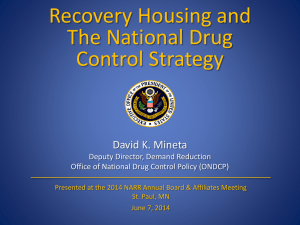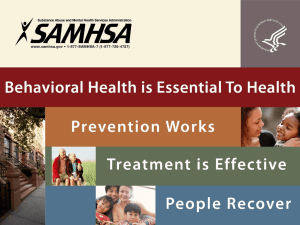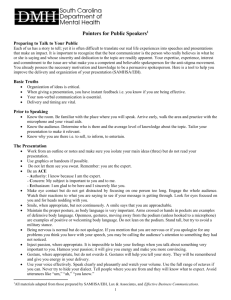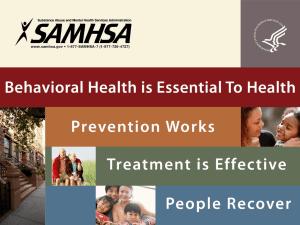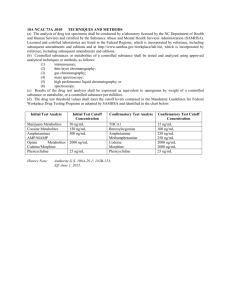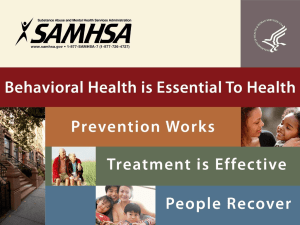SAMHSA Resources by Topic Each page is a different topic
advertisement
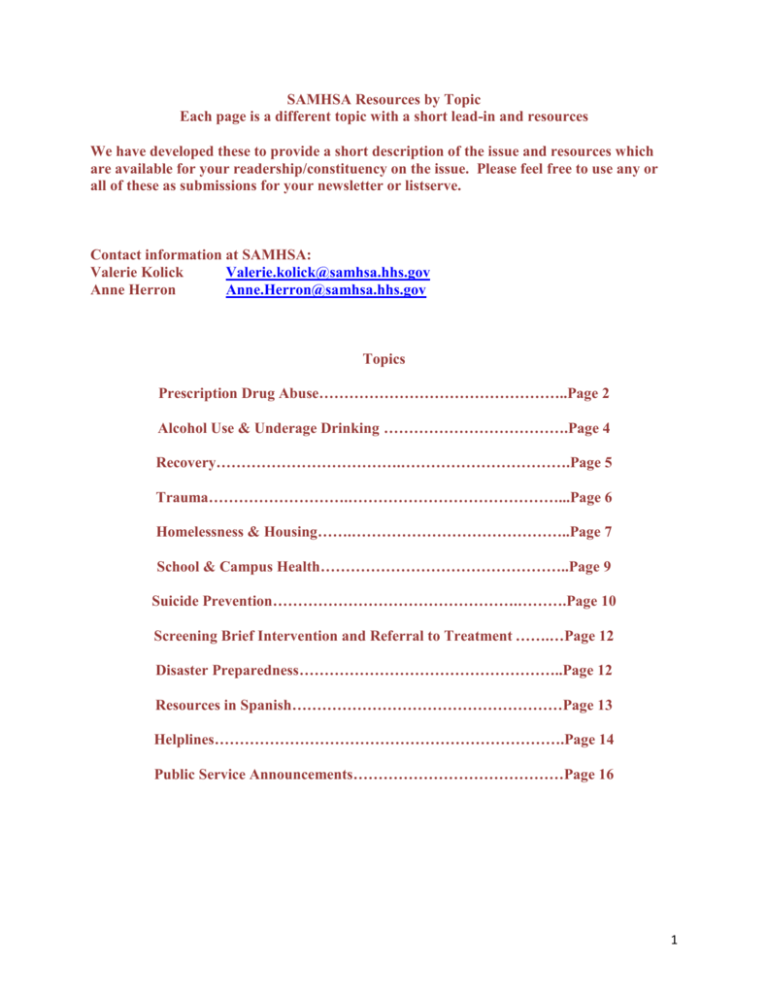
SAMHSA Resources by Topic Each page is a different topic with a short lead-in and resources We have developed these to provide a short description of the issue and resources which are available for your readership/constituency on the issue. Please feel free to use any or all of these as submissions for your newsletter or listserve. Contact information at SAMHSA: Valerie Kolick Valerie.kolick@samhsa.hhs.gov Anne Herron Anne.Herron@samhsa.hhs.gov Topics Prescription Drug Abuse…………………………………………..Page 2 Alcohol Use & Underage Drinking ……………………………….Page 4 Recovery……………………………….…………………………….Page 5 Trauma……………………….……………………………………...Page 6 Homelessness & Housing…….……………………………………..Page 7 School & Campus Health…………………………………………..Page 9 Suicide Prevention………………………………………….……….Page 10 Screening Brief Intervention and Referral to Treatment …….…Page 12 Disaster Preparedness……………………………………………..Page 12 Resources in Spanish………………………………………………Page 13 Helplines…………………………………………………………….Page 14 Public Service Announcements……………………………………Page 16 1 Prescription Drug Abuse Prescription drug misuse and abuse is the intentional or unintentional use of medication without a prescription, in a way other than prescribed, or for the experience or feeling it causes. Results from the 2013 National Survey on Drug Use and Health (NSDUH) (PDF | 3.2 MB) indicate that about 15.3 million people aged 12 or older used prescription drugs non-medically in the past year, and 6.5 million did so in the past month. This issue is a growing national problem in the United States. Prescription drugs are abused and misused more often than any other drug, except marijuana and alcohol. Current Publications: Free online CME courses on “Prescribing Opioids for Chronic Pain.” SAMHSA in partnership with Boston University, School of Medicine www.opioidprescribing.comm Physician Clinical Support System for Opioids (PCSS-O): free physician mentoring from experts on clinical topics such as prescribing opioids for chronic pain and officebased treatment of opioid-dependent patients www.pcss-o.org Physician Clinical Support System for Buprenorphine (PCSS-B): free physician mentoring from experts on office-based treatment of opioid addiction with buprenorphine www.pcssb.org “Prevention Resources on the Nonmedical Use of Prescription Drugs” https://captus.samhsa.gov/access-resources/samhsas-capt-develops-important-newprevention-resources-nonmedical-use-prescription “Managing Chronic Pain in Adults with or in Recovery from Substance Use Disorders” http://store.samhsa.gov/product/TIP-54-Managing-Chronic-Pain-in-AdultsWith-or-in-Recovery-From-Substance-Use-Disorders/SMA13-4671 Recent Releases: SAMHSA Issues Opioid and Alcohol Brief Guides for Medication-Assisted Treatment Substance Abuse and Mental Health Services Administration (SAMHSA) has released two new publications that focus on improving the health of patients with an opioid use disorder or alcohol use disorder by using medication-assisted treatment (MAT). These guides are targeted for primary care and specialty providers only. Each of the brief guides covers the range of care involving MAT, including referrals to care as appropriate. Details on how to order free copies of the Guides can be found by clicking on the following links. To download the opioid brief guide, click here. To download the alcohol brief guide, click here "NCADD's Consumer Guide for Medication-Assisted Recovery," which is geared to the general public, is available by clicking here. Primary care and specialty providers may have patients that are misusing opioids or abusing alcohol. 2 These patients could benefit from medication-assisted treatment (MAT). Healthcare providers can help improve their patients' health by learning about MAT for opioid and alcohol use disorder from these two brief guides. Each brief guide covers the range of care involving MAT, including referrals to care as appropriate. Opioid Overdose Prevention Toolkit - Updated 2014 Equips communities and local governments with material to develop policies and practices to help prevent opioid-related overdoses and deaths. Addresses issues for first responders, treatment providers, and those recovering from opioid overdose. Updated in 2014. http://store.samhsa.gov/product/OpioidOverdose-Prevention-Toolkit-Updated-2014/SMA14-4742 3 Alcohol Use & Underage Drinking Slightly more than half of Americans aged 12 or older report being current drinkers of alcohol. SAMHSA’s National Survey on Drug Use and Health (NSDUH) reports that in 2013 there were 136.9 million current alcohol users aged 12 or older, with 22.9% classified as binge drinkers and 6.3% as heavy drinkers. About 17.3 million of these, or 6.6%, met criteria for an alcohol use disorder in the past year. Excessive alcohol use, including underage drinking and binge drinking (drinking 5 or more drinks on a single occasion for men or 4 or more drinks on an occasion for women), can increase a person’s risk of developing serious health problems, including brain and liver damage, heart disease, hypertension, and fetal damage in pregnant women Medication for the Treatment of Alcohol Use Disorder: A Brief Guide Provides guidance for the use of medication-assisted treatment for alcoholism and alcohol abuse in clinical practice. Summarizes approved medications and discusses screening and patient assessment, treatment planning, and patient monitoring http://store.samhsa.gov/product/Medication-for-the-Treatmentof-Alcohol-Use-Disorder-A-Brief-Guide/All-New-Products/SMA15-4907 Talk. They Hear You. Smart Phone App Practice talking to your kids about the dangers of alcohol. Prepare for one of the most important conversations you may ever have with your kids about underage drinking. SAMHSA’s “Talk. They Hear You.” app is available on desktop computers and on the go from the App StoreSM, Google Play™, the Windows® Store, and Windows® Phone Store. 4 Recovery The adoption of recovery by behavioral health systems in recent years has signaled a dramatic shift in the expectation for positive outcomes for individuals who experience mental and/or substance use conditions. Today, when individuals with mental and/or substance use disorders seek help, they are met with the knowledge and belief that anyone can recover and/or manage their conditions successfully. The value of recovery and recovery-oriented behavioral health systems is widely accepted by states, communities, health care providers, peers, families, researchers, and advocates including the U.S. Surgeon General, the Institute of Medicine, and others. Guiding Principles and Elements of Recovery-Oriented Systems of Care. What do we know from the research? Examines the research that supports the principles of recovery and systems of care elements as defined by the National Summit on Recovery, and reviews the literature that supports services and systems improvements based on recovery-oriented approaches. http://store.samhsa.gov/product/Guiding-Principles-and-Elements-of-Recovery-OrientedSystems-of-Care/SMA09-4439 The Road to Recovery. Language Matters. Talking about Addiction and Recovery Discusses the role language plays in forming opinions on addiction and mental health issues, explores what research has shown about the use of language, and offers tips on how to speak about addiction, treatment, and recovery to support those seeking help. http://store.samhsa.gov/product/Language-Matters-Talking-About-Addiction-andRecovery/SMA10-4502 Getting Started with Evidence-based Practices: Supported Employment Kit Provides practice principles about supported employment, an approach to vocational rehabilitation for people with serious mental illnesses. Promotes the belief that everyone with a serious mental illness is capable of working competitively in the community. http://store.samhsa.gov/product/Supported-Employment-Evidence-Based-Practices-EBPKIT/SMA08-4365 Getting Started with Evidence-based Practices: Illness Management and Recovery Kit Guides public officials in developing illness-management and recovery mental health programs that emphasize personal goal-setting and actionable strategies for recovery. Offers guidance grounded in evidence-based practices. Kit includes 10 booklets http://store.samhsa.gov/product/Illness-Management-and-Recovery-Evidence-Based-PracticesEBP-KIT/SMA09-4463 What are Peer Recovery Support Services Explains peer recovery support services designed and delivered by people in recovery from alcohol and drug addiction. Discusses types of peer support for recovery, the adaptability and value of peer recovery support services, and crosscutting core principles. http://store.samhsa.gov/product/What-Are-Peer-Recovery-SupportServices-/SMA09-4454 5 Trauma Trauma and violence are widespread, harmful, and costly public health concerns. They have no boundaries with regard to age, gender, socioeconomic status, race, ethnicity, or sexual orientation. Trauma is a common experience for adults and children in American communities, and it is especially common in the lives of people with mental and substance use disorders. For this reason, the need to address trauma is increasingly seen as an important part of effective behavioral health care. Coping With Grief After Community Violence Tips for Survivors Offers tips for coping with grief after an incident of community violence. Introduces some of the signs of grief and anger, provides useful information about how to cope with grief, and offers tips for helping children deal with grief. http://store.samhsa.gov/product/Coping-With-Grief-After-CommunityViolence/SMA14-4888 Tips for Talking With and Helping Children and Youth Cope After a Disaster or Traumatic Event: A Guide for Parents, Caregivers, and Teachers. Helps parents and teachers recognize common reactions children of different age groups (preschool and early childhood to adolescence) experience after a disaster or traumatic event. Offers tips for how to respond in a helpful way and when to seek support. http://store.samhsa.gov/product/Tips-forTalking-With-and-Helping-Children-and-Youth-Cope-After-a-Disaster-or-Traumatic-Event-AGuide-for-Parents-Caregivers-and-Teachers/SMA12-4732 Practice Guidelines: Core elements in Responding to Mental Health Crises Presents guidelines to improve services for people with serious mental illness or emotional disorder who are in mental health crises. Defines values, principles, and infrastructure to support appropriate responses to mental health crises in various situations. http://store.samhsa.gov/product/CoreElements-for-Responding-to-Mental-Health-Crises/SMA09-4427 6 Homelessness & Housing Homelessness and health concerns often go hand in hand. At the most extreme, a person can become chronically homeless when his or her health condition becomes disabling and stable housing is too difficult to maintain without help. People with substance use and other mental health disorders experience even greater barriers to accessible housing than their counterparts due to various reasons including: income deficits, stigma, and the need for community wraparound services. Stable housing provides the foundation upon which people build their lives. Without a safe, affordable place to live, it is almost impossible to achieve good health or to achieve one’s full potential. But, according to the Department of Housing and Urban Development (HUD), 578,424 people were homeless on any given night, including 128,061 children under the age of 18. Of those who were homeless, 117,084 are categorized as severely mentally ill, and 116,770 suffer from chronic substance abuse. While the number of people experiencing homelessness has declined since 2007, much work remains to be done to reach the goal of ending homelessness in the United States. Current Publications: TIP 55: Behavioral Health Services for People Who Are Homeless Equips those who provide services to people who are homeless or at risk of homelessness and who need or are in substance abuse or mental illness treatment with guidelines to support their care. Discusses prevention and treatment as part of integrated care. http://store.samhsa.gov/product/TIP-55Behavioral-Health-Services-for-People-Who-Are-Homeless/SMA13-4734 Homelessness and Substance Use Disorder Treatment: Recovery-Oriented Housing and Achieving Healthy Lifestyles Video examines the relationship between homelessness and substance abuse treatment from both a program perspective and a policy perspective. Explores permanent supportive housing, comprehensive treatment protocols, and recovery support systems. http://store.samhsa.gov/product/Homelessness-and-Substance-Use-Disorder-TreatmentRecovery-Oriented-Housing-and-Achieving-Healthy-Lifestyles/SMA10-4484 Permanent Supportive Housing Evidence-Based Practices (EBP) Kit Outlines the essential components of supportive housing services and programs for people with mental illness. Discusses how to develop new programs within mental health systems that are grounded in evidence-based practices. Kit includes eight booklets. http://store.samhsa.gov/product/Permanent-Supportive-Housing-Evidence-Based-Practices-EBPKIT/SMA10-4510 More Resources: SAMHSA’s Homelessness Resource Center (HRC) is an interactive learning community dedicated to disseminating knowledge and best practices to prevent and end homelessness. It includes providers, consumers, policymakers, researchers, and public agencies at Federal, State, 7 and local levels. The HRC Website consists of a digital library of over 9,000 resources related to homelessness, mental illness, substance use, co-occurring disorders, and traumatic stress. http://homeless.samhsa.gov/Default.aspx The Projects for Assistance in Transition from Homelessness (PATH) Website offers information and resources on the PATH program. The PATH program is a formula grant to the 50 states, the District of Columbia, Puerto Rico, the Northern Mariana Islands, Guam, American Samoa, and the U.S. Virgin Islands. There are nearly 600 local organizations that provide PATH services. PATH provides services to people with serious mental illness, including those with cooccurring substance use disorders, who are experiencing homelessness or at imminent risk of becoming homeless. http://pathprogram.samhsa.gov/Default.aspx 8 School & Campus Health Young people face a variety of life challenges that can affect their mental health and/or use or abuse of alcohol and other drugs. Schools and campuses should be safe havens for them to grow and learn. Both settings offer a number of mental health promotion and substance use prevention activities, yet America’s schools and campuses are facing challenging public health issues such as bullying, violence, delinquency, alcohol use, and illegal or prescription drug abuse. Addressing the Mental Health Needs of Young Children and Their Families Describes how systems of care address the mental health needs of young children and their families. Explores the importance of social-emotional wellness, what a system of care is, and how young children can thrive as a result of systems of care. http://store.samhsa.gov/product/Addressing-the-MentalHealth-Needs-of-Young-Children-and-Their-Families/SMA10-4547 KnowBullying: Put the power to prevent bullying in your hand KnowBullying empowers parents, caregivers, and educators with the tools they need to start the conversation with their children about bullying. KnowBullying, a 2014 recipient of the Bronze Award in the Mobile category from the Web Health Awards, describes strategies to prevent bullying and explains how to recognize warning signs that a child is bullying, witnessing bullying, or being bullied. Includes a section for educators. http://store.samhsa.gov/product/KnowBullying-Put-thepower-to-prevent-bullying-in-your-hand/PEP14-KNOWBULLYAPP 9 Suicide Prevention Suicide is a serious public health problem that causes immeasurable pain, suffering, and loss to individuals, families, and communities nationwide. The causes of suicide are complex and determined by multiple combinations of factors, such as mental illness, substance abuse, painful losses, exposure to violence, and social isolation. Suicide prevention efforts seek to: Reduce factors that increase the risk for suicidal thoughts and behaviors Increase the factors that help strengthen, support, and protect individuals from suicide Suicide Prevention Lifeline: http://www.suicidepreventionlifeline.org/ Addressing Suicidal Thoughts and Behaviors in Substance Abuse Treatment: Quick Guide for Clinicians Based on TIP 50 Equips clinicians and other service providers a quick reference guide to addressing suicide and suicide prevention in clients with substance use disorders. Covers risk factors and warning signs for suicide, core competencies, and information for administrators and clinical supervisors. http://store.samhsa.gov/product/Quick-Guide-forClinicians-Based-on-TIP-50/SMA13-4793 Suicide Prevention Toolkit for Rural Primary Care This Toolkit can be used by all primary care providers, including those in non-rural settings. It contains tools, information, and resources to implement state-of-the art suicide prevention practices and overcome barriers to treating suicidal patients in the primary care setting. You’ll find assessment guidelines, safety plans, billing tips, sample protocols, and more. http://www.sprc.org/for-providers/primary-care-toolkit?sid=35059 Free Online Trainings for Suicide Prevention http://training.sprc.org/course/description.php#course4 Suicide Safe: The Suicide Prevention App for Health Care Providers Free from SAMHSAFor individuals at risk of suicide, behavioral health and primary care settings provide unique opportunities to connect with the health care system and access effective treatment. Almost half (45%) of individuals who die by suicide have visited a primary care provider in the month prior to their death, and 20% have had contact with mental health services.1 Suicide Safe, SAMHSA's new suicide prevention app for mobile devices and optimized for tablets, helps providers integrate suicide prevention strategies into their practice and address suicide risk among their patients. Suicide Safe is a free app based on SAMHSA's Suicide Assessment Five-Step Evaluation and Triage (SAFE-T) card. http://store.samhsa.gov/apps/suicidesafe/?utm_source=samhsahomebtmbanner&utm_medium=b anner&utm_content=suicideprevention&utm_campaign=apps 10 Screening Brief Intervention and Referral to Treatment SBIRT SBIRT is a comprehensive, integrated, public health approach to the delivery of early intervention and treatment services for persons with substance use disorders, as well as those who are at risk of developing these disorders. Primary care centers, hospital emergency rooms, trauma centers, and other community settings provide opportunities for early intervention with at-risk substance users before more severe consequences occur. http://www.samhsa.gov/sbirt/resources Free SBIRT CME/CE Course SBIRT is an intervention strategy that can take place in a wide variety of settings, with the aim to identify people who may be at risk of substance misuse or abuse. The early identification process can inform providers and guide them to appropriate referrals to treatment. The free course gives participants the added benefit of receiving Continuing Medical Education (CME) or Continuing Education (CE) credit. http://www.medscape.org/viewarticle/830331 TAP 33: Systems-Level Implementation of Screening, Brief Intervention, and Referral to Treatment (SBIRT) Describes core elements of screening, brief intervention, and referral to treatment (SBIRT) programs for people with or at risk for substance use disorders. Describes SBIRT services implementation, covering challenges, barriers, cost, and sustainability. http://store.samhsa.gov/product/TAP-33-Systems-Level-Implementation-of-Screening-BriefIntervention-and-Referral-to-Treatment-SBIRT-/SMA13-4741 11 Disaster Preparedness Disasters can occur naturally (such as tornadoes, hurricanes, earthquakes, floods, wildfires, mudslides, or drought) or be human-caused (such as mass shootings, chemical spills, or terrorist attacks). Preparing for, responding to, and recovering from disasters and traumatic events is essential to the behavioral health (mental health and substance use) of individuals and communities alike. Disaster Behavioral Health Preparedness and Response Resources Lists disaster preparedness and recovery resources for range of professionals who assist individuals and communities in coping with disaster. Topics include emergency preparedness, training, disaster response, stress prevention and management, and suicide prevention. http://store.samhsa.gov/product/Disaster-Behavioral-Health-Preparedness-and-ResponseResources/DTAC11-CATALOG SAMHSA Behavioral Health Disaster Response App Access critical, disaster-related behavioral health resources right from your phone with the SAMHSA Disaster App. In a disaster, it's essential that behavioral health responders have the resources they need—when and where they need them. The SAMHSA Disaster App makes it easy to provide quality support to survivors. Users can navigate pre-deployment preparation, on-theground assistance, post-deployment resources, and more—at the touch of a button from the home screen. Users also can share resources, like tips for helping survivors cope, and find local behavioral health services. And, self-care support for responders is available at all stages of deployment. http://store.samhsa.gov/apps/disaster/?WT.ac=AD_20140103_DISASTERAPPBADGE 12 Resources in Spanish La Administración de Salud Mental y Abuso de Sustancias (SAMHSA, por sus siglas en inglés) es una agencia del Departamento de Salud y Servicios Humanos de los Estados Unidos que tiene como visión el desarrollo de una vida en comunidad para todos. Para lograr esta visión, la agencia se ha enfocado en crear y facilitar tratamientos y servicios de apoyo para la recuperación necesarios para personas que sufren o se encuentran en riesgo de padecer condiciones de salud mental o problemas relacionados con el abuso de sustancias. www.samhsa.gov/espanol (SAMHSA Website in Spanish) MentalHealth.Gov MentalHealth.gov proporciona acceso a información del gobierno de los Estados Unidos sobre salud mental y sus consecuencias. El objetivo de MentalHealth.gov es educar y brindar orientación: al público en general, profesionales de la salud, proveedores con preparación para manejar emergencias, encargados de formular políticas públicas, líderes empresariales y del gobierno, sistemas escolares y comunidades locales. http://espanol.mentalhealth.gov/ (MentalHealth.Gov in Spanish) Mes Nacional de la Recuperación Septiembre es el Mes de la Recuperación, llevamos 25 años celebrándolo. El Mes de la Recuperación promueve los beneficios sociales de la prevención, el tratamiento y la recuperación de los trastornos mentales y por uso de sustancias. El tema de este año: "Únete a las voces para la Recuperación: Alza tu voz, Comparte el mensaje", anima a las personas a hablar abiertamente sobre los trastornos mentales y por uso de sustancias, y presenta la realidad de que la recuperación es posible. Asimismo, promueve diferentes maneras de reconocer las condiciones de salud mental y de obtener ayuda. http://recoverymonth.gov/?sc_lang=es-US or http://recoverymonth.gov/LanguageChange.aspx (National Recovery Month Resources in Spanish – This is in September) Descripciones de algunas de las enfermedades mentales más communes Se presentan varias descripciones breves de algunas de las enfermedades mentales más comunes. Visite el sitio Web de Substance Abuse and Mental Health Services Administration [Administración de Servicios sobre Salud Mental y Abuso de Sustancias] y el sitio del National Institutes of Mental Health [Instituto Nacional de Salud Mental] para conocer más sobre cualquiera de ellas. (Description of common mental illnesses) 13 Helplines Suicide Prevention Lifeline: http://www.suicidepreventionlifeline.org/ Behavioral Health Treatment Locator: Find alcohol and drug abuse treatment or mental health treatment facilities and programs around the country at findtreatment.samhsa.gov. SAMHSA’s National Helpline is a free, confidential, 24/7, 365-day-a-year treatment referral and information service (in English and Spanish) for individuals and families facing mental health and/or substance use disorders. Call 1-800-662HELP (4357) or visit the online treatment locators The Disaster Distress Helpline is a national hotline dedicated to providing year-round immediate crisis counseling for people who are experiencing emotional distress related to any natural or human-caused disaster. This toll-free, multilingual, and confidential crisis support service is available to all residents in the United States and its territories. Stress, anxiety, and other depression-like symptoms are common reactions after a disaster. Call 1-800-985-5990 or text TalkWithUs to 66746 to connect with a trained crisis counselor. Behavioral Health Treatment Services Locator Find alcohol and drug abuse treatment or mental health treatment facilities and programs around the country at findtreatment.samhsa.gov. Buprenorphine Physician & Treatment Program Locator Find information on locating physicians and treatment programs authorized to treat opioids, such as heroin or prescription pain relievers, at buprenorphine.samhsa.gov/bwns_locator/. Opioid Treatment Program Directory Find treatment programs in your state that treat addiction and dependence on opioids, such as heroin or prescription pain relievers, at dpt2.samhsa.gov/treatment/. Veteran's Crisis Line 1-800-273-8255 TTY: 1-800-799-4889 Website: www.veteranscrisisline.net 14 Connects veterans in crisis (and their families and friends) with qualified, caring Department of Veterans Affairs responders through a confidential, toll-free hotline, online chat, or text. Drug-Free Workplace 1-800-WORKPLACE (967-5752) Website: workplace.samhsa.gov Assists employers and union representatives with policy development, drug testing, employee assistance, employee education, supervisor training, and program implementation. 15 Public Service Announcements The following PSAs are available for use in any settings that would provide information to the public or patients/clients: Talk. They Hear You. Underage Drinking Campaign: http://www.samhsa.gov/talk-theyhear-you/partner-resources/psas Child Trauma: https://www.youtube.com/watch?v=ACQhoe_cvg&index=2&list=PLBXgZMI_zqfQKqUlrdWYcvu6HfaNPUBPS Additional Resource HCV Snapshot: An Introduction to Hepatitis C for Health Care Professionals: HCV Snapshot is a free, 90-minute online course. It is designed to briefly familiarize medical and behavioral health professionals with hepatitis C. The ATTC Network's newest resource, HCVCurrent, is designed to help providers know more about Hepatitis C--and help people like Kimberly who may be struggling with a substance use disorder and/or mental illness and Hepatitis C. http://www.attcnetwork.org/Projects/HCV_Snapshot.aspx 16
